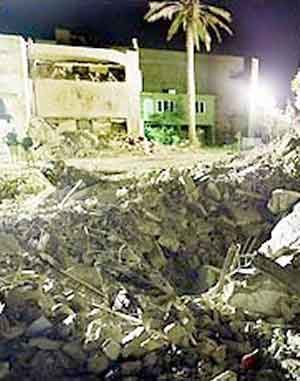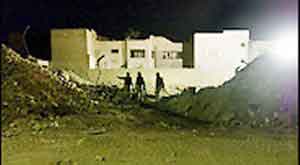
U.S. military engineers
began an intensive effort to
excavate the site
of a bombing on April 7 that
military officials
still think may have killed
Saddam Hussein. |
BAGHDAD, Iraq
- Using bulldozers, backhoes and loaders, U.S. Army combat engineers dug
through a rubble-filled crater Wednesday, trying to determine whether Saddam
Hussein died in an April 7 airstrike on the house where he was believed
to be hiding.
The site was attacked
two days before U.S. forces took control of the capital. The U.S. military
said at the time that it had reliable information that Saddam and members
of his family and entourage were there.
"For us to expend
the amount of money it took to destroy this place, it must have been a
key target," said Maj. Scott Slaten of the newly arrived 1st Armored Division,
which is now assuming responsibility for Baghdad.
An engineering unit
of the Utah National Guard was excavating the site and moving the rubble
to an undisclosed location to be examined for human remains, Slaten said.
The United States
does not know Saddam's fate. Video allegedly taken on April 9 showed him
atop a vehicle waving to supporters in the Azamiyah neighborhood. But U.S.
officials question the accuracy of the footage. |
| For the six weeks
that followed the end of fighting, the two-floor home in the upscale Mansour
district - in which at least 14 civilians are believed to have died - was
left mostly undisturbed.
On Wednesday afternoon,
Lt. Gen. David McKiernan - commander of U.S. ground troops in Iraq - said
searchers combing through the rubble in al-Mansour had not yet come across
any DNA that would prove that Saddam had been killed.
"We don't have any
evidence of any blacklisted remains," he said, referring to remains of
Iraqi regime figures who have been blacklisted by the U.S. military. He
added that U.S. troops searched the site after they occupied Baghdad.
|
 In a search for the
remains of Saddam Hussein, American military engineers started a 24-hour
excavation at a house in Baghdad
In a search for the
remains of Saddam Hussein, American military engineers started a 24-hour
excavation at a house in Baghdad
bombed on April
7. |
"We did this initially,
(but) it's been apparent that we didn't do a thorough enough job," McKiernan
said. "We will account for Saddam Hussein (and his sons) Qusai and Odai
at some point."
"We did this initially,
(but) it's been apparent that we didn't do a thorough enough job," McKiernan
said. "We will account for Saddam Hussein (and his sons) Qusai and Odai
at some point."
As he spoke, a bulldozer,
a backhoe, two loaders and a dozen heavy trucks were hard at work at the
site, which was covered by a thick layer of dust from the pulverized bricks.
Dozens of U.S. troops,
three Bradley fighting vehicles and concertina wire protected the engineers
clearing the debris.
Officers said they
expected to be done with excavation by June 11. Crews were expected to
remain for another week to 10 days to repair nearby homes damaged in the
airstrikes and to clean the site and surrounding street.
"There's nothing
interesting here, just a lot of rubble," said Pfc. Walter Phillips, 30,
of Chicago, as he stood near his backhoe at the edge of a 15-foot crater.
Iraqis nearby doubted
whether the soldiers would find the remains of Saddam, who they suspect
was hiding at another house, just yards away.
"No, no - Saddam
ran away. He's hiding," said Munther Meki, a grocer whose shop - its front
window gone and shelves empty - is next to the destroyed house.
Meki said Saddam's
government rented a small house opposite the targeted building about six
months ago and that official-looking vehicles were parked outside before
and during the war.
"Nobody knew for
sure if it was Saddam or someone else," Meki said.
Except for the broken
windows, the empty, unfurnished house appeared structurally undamaged.
Its metal doors were held shut with a heavy chain and lock, and the interior
was littered with smashed glass and broken bricks.

|

